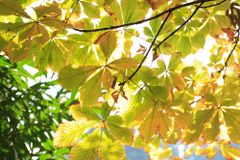FAQ About Iron Chlorosis in Trees & Shrubs

Just like people, plants need certain nutrients to thrive. When your trees and shrubs don’t get the iron they need, they’ll develop iron chlorosis, which can result in their deaths. Learn the signs of this condition and the tree care best practices to address it with these frequently asked questions.
Iron Chlorosis FAQ
What is chlorosis?
Chlorosis is caused by iron deficiency and is most common among maple and oak trees in soils with a pH higher than 7. More acidic soils tend to be low in iron, so trees and shrubs can’t get what they need. Higher pH soils are found in areas with low precipitation levels.
What are the signs of chlorosis?
 When a tree or shrub experiences iron deficiency, their leaves will start to lose their color. The green leaves will first turn pale green, then fade to yellow. The yellower the leaves, the more advanced the deficiency and the more likely the tree is going to die.
When a tree or shrub experiences iron deficiency, their leaves will start to lose their color. The green leaves will first turn pale green, then fade to yellow. The yellower the leaves, the more advanced the deficiency and the more likely the tree is going to die.
How do you treat chlorosis?
Among the several tree care treatments, one of the most effective is a trunk injection of iron sulfate or ferric ammonium citrate. These iron compounds are either dry or liquid. Holes are drilled into the lower end of the trunk, after which the compounds are injected. They are more effective when done in spring or summer.
How do you prevent chlorosis?
If your soil is acidic, prevention will be an essential part of your tree care plan. Have your soil tested for pH, and only plant trees that don’t require as much iron, such as the Norway maple or the Scotch pine. When the time comes for lawn fertilization, choose a fertilizer with a high iron content.
If you’re worried that your plants have iron chlorosis, seek an expert opinion from Eden Lawn Care & Tree Service in Lincoln, NE. The locally owned and operated company has more than 30 years of experience offering tree trimming, lawn maintenance, and iron injections. Learn more about their services on their website, and call (402) 488-3177 to request a free estimate.
About the Business
Have a question? Ask the experts!
Send your question

